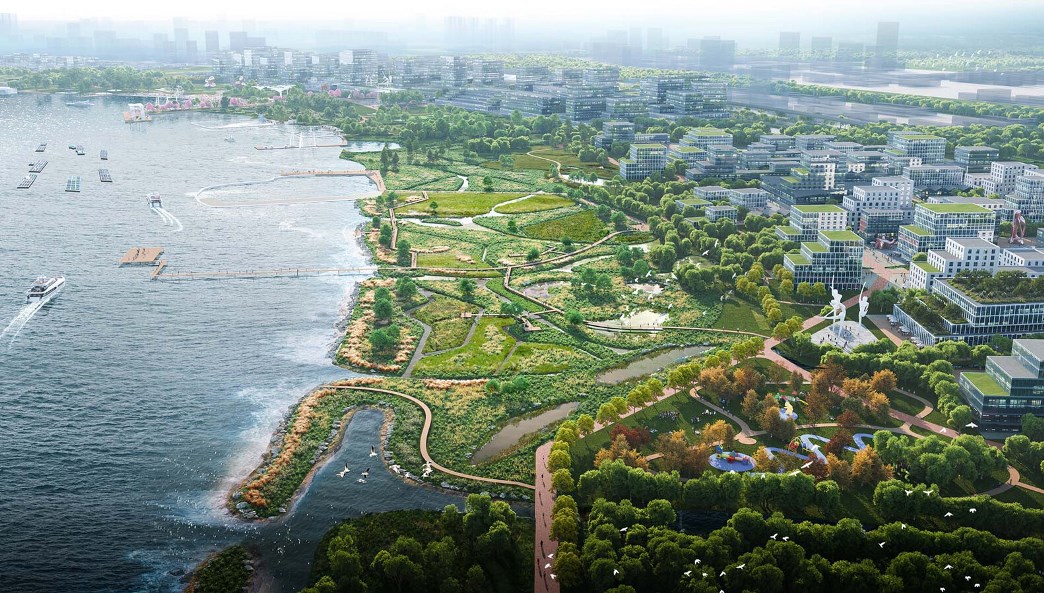On October 27, 2022 the Rotterdam-based design firm KCAP was awarded first prize in the competition for the International Coastline Conceptual Design for the Yantai Economic and Technological Development Zone in Yantai, Shandong, China, that took place in June.
Objective was to transform the underused, ecologically-damaged (mostly by unplanned fish farms the destroyed the mangroves forest) coastal area bordering the city of Yantai into a vibrant, international urban district with a beautiful natural coastline.
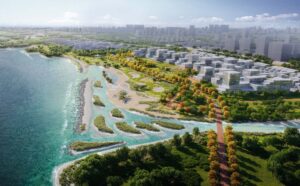 KCAP’s vision, Yantai Seafront Garden, spans several scales and is rooted in the city’s evolution from North-eastern China’s historical open gateway to an Economic Development Zone.
KCAP’s vision, Yantai Seafront Garden, spans several scales and is rooted in the city’s evolution from North-eastern China’s historical open gateway to an Economic Development Zone.
Key to the proposal is restoring the coastal areas, by returning the artificial coastline and production facilities (i.e. fish ponds) to nature, and implementing measures that protect it from erosion while creating new ecological habitats.
“In our view, a coastline is never just a simple ‘line’ but a system that encompasses all the elements around it. In the case of Yantai, this means a multidimensional approach was needed that includes the city, mountains and coastal landscape,” says Ya-Hsin Chen, Associate Partner at KCAP.
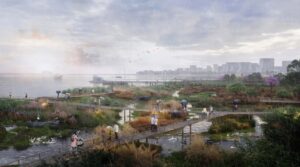 He explained that “the redesigned coastline had to be extensive, an integral part of the existing urban space.”
He explained that “the redesigned coastline had to be extensive, an integral part of the existing urban space.”
“It should also be inclusive, respect the existing while at the same time being innovative and geared towards active lifestyles. And, as with any long term planning strategy, it should be adaptable,” he continued.
Chen concluded, “The planning and management of a project on this scale is always a dynamic process, and every step forward is a pre-set and triggers the next actions and projects.”
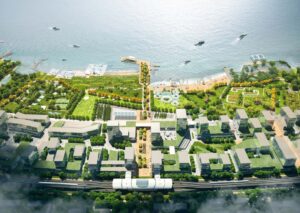 Yantai Seafront Garden comprises a planning strategy for the entire area, as well as a set of detailed spatial frameworks.
Yantai Seafront Garden comprises a planning strategy for the entire area, as well as a set of detailed spatial frameworks.
KCAP created an overall scheme for a 95 km long stretch of coastline, with 27,3 km2 consisting of coastal space.
Within this larger territory, there is extra focus on an 18 km key design area. KCAP drafted in-detail designs for a section of approximately 1 km2 within this 18 km area.
The planning area includes four distinct ‘habitats’: the zone between the mountains and city, which will be deployed for water containment; the actual urban centre, set up as a sponge city; the coast, conceived as a resilient tidal area; and the sea itself.
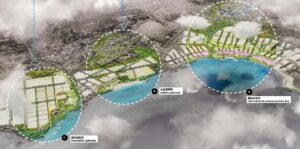 “To ensure that the development of both city and coastline are safe ánd ecologically founded, we adopted a strategy of shoreline restoration, protection and fortification, and a triple protection strategy – offshore, in the tidal zone and with a coastal dike,” explained Ruurd Gietema, Partner at KCAP.
“To ensure that the development of both city and coastline are safe ánd ecologically founded, we adopted a strategy of shoreline restoration, protection and fortification, and a triple protection strategy – offshore, in the tidal zone and with a coastal dike,” explained Ruurd Gietema, Partner at KCAP.
The plan aims to rebuild the connection between the mountains and sea. By creating continuous natural areas, the ecosystem will be restored, which will foster biodiversity.
The strategy also promotes the development and transformation of Yantai into a community based in ecology, and aims to prevent abrupt, ad-hoc urbanization which could lead to further fragmentation of the natural areas.
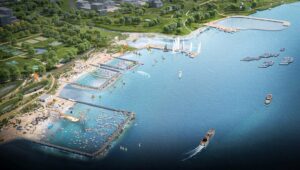 Within the larger framework, there was specific focus on an 18 km key design area because of its potential. Being the most open, green gateway it can act as a driving force for the overall development.
Within the larger framework, there was specific focus on an 18 km key design area because of its potential. Being the most open, green gateway it can act as a driving force for the overall development.
Here, in Huangshi Talent Bay, various public and social gatherings can take place, different lifestyles interact, and landscapes merge.
Within this development, the team gave special attention to the design of one singular area: International Communication Bay. Within this 1 km2, detailed-landscape design area, 3 clusters were defined: the Talent Port, the Tidal Community and the Lagoon Community.
Talent Port is a distinctly urban cluster. It includes a host of public functions, to be built along a central axis connecting the rail station and the harbour.
A central feature is the International Communication Center, which is surrounded and supported by various landscaped public spaces like the Expo park, an open-air events space. In designing the Tidal Community, the designers drew closely from nature. They recovered the natural tidal zone by removing the road and artificial shoreline, and used the tidal movements to create salt marshes instead.
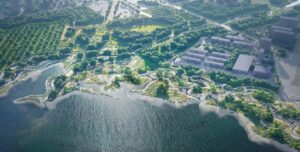 By deploying the area’s natural strengths, KCAP was able to extend the landscape, creating a transitional zone between the village and wetlands, which serves both as a unique seafront park and as an ecological habitat.
By deploying the area’s natural strengths, KCAP was able to extend the landscape, creating a transitional zone between the village and wetlands, which serves both as a unique seafront park and as an ecological habitat.
The Lagoon Community is set in a shoreline landscape dominated by newly created, desalinated lagoons; these offer room for swimming and socializing, but also have an ecological function.
“We feel that Yantai Seafront Garden clearly illustrates our vision on integrated design. KCAP has created a planning strategy that not only respects local and natural assets, but actually considers the sea, the coastline, the mountains and the city as one. The project explores the possibilities and solutions of coastline development on different scales and themes, advocating a multi-level, sustainable approach,” continued Ya-Hsin Chen.
“Our aim is to integrate the landscape concept, nature conservation, a sustainable water system and urban development. Combined, these serve as the foundation for a high quality environment for both human and natural life,” he concluded.
The urban center offers a range of nature-based experiences and serves as a leisure centre for all of Huangshi Talent Bay.
All images courtesy of KCAP.

